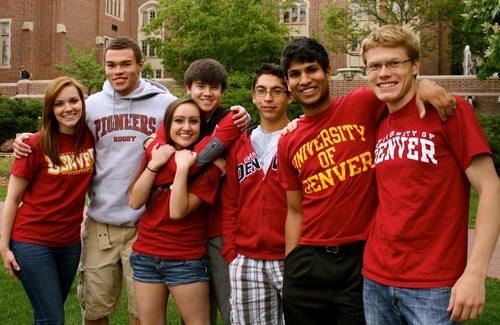 Photo by: Jill Hamilton
Photo by: Jill Hamilton
Less than 30 percent total students represent a minority at DU, with 20 percent of students representing a domestic minority, and 9 percent of students representing an international minority, according to the 2011-2012 annual report conducted by the Office of Institutional Research and Analysis (IRA). Student diversity was celebrated last week at the 11th annual Diversity Summit for Inclusive Excellence and the 29th annual Festival of Nations.
The IRA’s report states that 68 percent of undergraduate students at DU identified as Caucasian. The leading domestic minority were Hispanics/Latinos with 8 percent, followed by Asian Americans at 4 percent and African Americans and Multiracial students (2 or more races) at 3 percent each. There are less than 1 percent who identify as American Indians and native Hawaiians.
To gauge the campus climate concerning diversity, the Center for Multicultural Excellence (CME) conducted an Inclusive Excellence Assessment last February, to which over 4,000 members of the DU community responded.
“Consistently, there was some sense that the community was not as diverse as it could be,” said Frank Tuitt, associate provost for Inclusive Excellence. “I think we’re pretty honest about where we are. Being an inclusive campus is a priority, but we recognize there is still work to be done for us to get there.”
Tuitt said there is a difference between valuing diversity and actually being diverse.
“The important thing to recognize is that we’ve made some progress over the last few years,” said Tuitt. “I think we’re at a point now where we need to re-focus our attention on diversity.”
CME works with the Office of Undergraduate Admissions and Human Resources (HR) to help support inclusive excellence and diversity recruitment across the institution, both on the faculty/staff and student side. The Admissions Office said the demographics look promising for the incoming class next fall, but the final numbers will not be available until May 16.
Despite the institutional commitment to inclusive excellence, Chris George, director of the Office of Financial Aid, said DU does not use financial aid as an incentive to increase diversity.
“We are race-neutral in our awarding policies,” he said. “We award merit-based aid to students with the best academic standing and need-based aid to students with the most financial need, regardless of minority status.”
George said it would be great to have more diversity on campus, but that it is only an indirect benefit of financial aid. He said the financial aid budget continues to increase in an effort to make DU more affordable for all students.
“Diversity is about more than race and ethnicity,” said George. “Socioeconomic status is part of that too, and that’s what we deal with here.”
Craig Hirokawa, a junior at DU and active member of the Asian Student Alliance (ASA), said he agreed with George.
“Diversity isn’t just ethnic,” he said. “It’s about appreciating the multiplicity of our experiences.”
Hirokawa said in terms of numerical diversity, DU definitely has room for growth. He said the percent of Asian students at DU has gone down from 5 percent to 4 percent in the three years he has been here.
“However, the campus climate has improved a lot in the last three years,” said Vanessa Teck, another active junior in ASA. “People are getting more involved and getting excited about diversity events, and there’s been a lot of support from the administration.”
Teck used the example of Lambda Chi Alpha’s and Tri- Delta’s “Cowboys and Indians” party that caused controversy at the beginning of March.
“Now we can start approaching discrimination issues as discussions, instead of just conflicts,” she said.
Hirokawa and Teck said they are sometimes lumped together with Asian international students because of their physical appearance, even though their families are Americans.
“We still get stereotypical comments,” said Teck.
According to Tuitt, about 20 percent of people replying to the Inclusive Excellence Assessment said they had experienced an act of discrimination; up to 30 percent said they had witnessed an act of discrimination at DU.
“I don’t think there’s anyone on campus who believes we’ve ‘arrived’ in terms of diversity,” said George.











